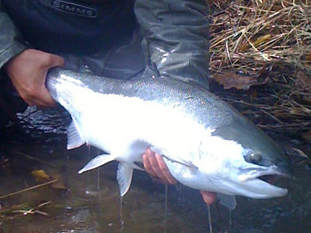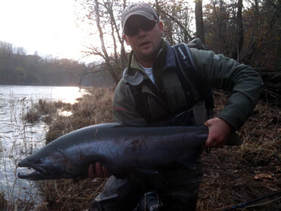Swinging Flies for Steelhead
by: Andrew Moy
Steelhead have 2 basic instincts or responses while feeding or "taking" in the river. The first is what I call the "intercept" response. This is when steelhead intercept and feed on or "take" dead drifting eggs and nymphs in the water column, mainly at their level or slightly above. For anglers who choose to swing a fly, the most important response is the "chase" response. This response comes from their general predatory nature while in the lake or ocean and also while as a juvenile in the river chasing aquatic bugs and small baitfish, especially towards the surface.
Very often, the best way to approach swinging flies is to keep the fly in the upper part of the water column. Although there are times that it is necessary to fish deeper, many times the best approach is to actually stay higher. Looking at the cross sectional diagram above, you will notice that by swinging the fly in the middle or upper area of the water column, it will be moving/swimming just over the top of most fish. Steelhead want to feed or "take" upwards during the chase response.
|
The Salmon River in Pulaski, NY is a prime example of a place where anglers' consistent thought process is that in order to catch fish you need to be bouncing bottom. The Salmon River is a relatively shallow river. The water is clear and it most often runs clear even in higher flows. The average depth where steelhead are lying here is from 12-48 inches of water. If a fish is lying in 3 feet of water and is suspended 8-12 inches off the bottom, then swinging the fly 4-20 inches beneath the surface is usually plenty deep to trigger a response. Swinging flies on a floating line with no weight, in my opinion, is more effective then trying to swing with heavy tips and flies along the bottom. Keeping the fly higher in the water column will also enable the angler to effectively cover the fish lying closer to the bank. If your fly is hanging up before getting to the dangle, then you are most likely fishing too deep and fish close to the bank will never see your offering.
|
Arguments can be made as to the optimal speed of your swing. I can vividly remember an explosive take on a fast skated dry fly on the North Umpqua River years ago. That was during the summer and water temps were warmer. During fall and winter fishing, I prefer a slow to moderate speed swing. Make sure to keep the fly swimming and not slow the fly down with mending. Over mending causes the tension to come out of the swing and the fly to dead drift in the current. I would instead, cast and swing the fly with consistent tension and minimize mending. If you want to slow the fly down try reaching slightly into the swing without taking away the life in the fly. Especially early in the season, until mid-late November, I would try to fish faster runs in-between the pools with this technique. As the season gets colder, I don't necessarily change my technique, rather, I change where I apply it. I start to focus more on softer currents and tail-outs. Even though it is colder, don't be tricked to fish along the bottom.
|
Pressure - Barometric & Angler
When we think of steelhead fishing we imagine rainy, snotty days. When barometric pressure is falling, steelhead, will often not respond well. Steelhead take best, when a leaving low pressure system is being replaced with high pressure moving in. Easterly winds are often associated with falling pressure and westerly winds are often associated with rising pressure. It is common on the Salmon River that steelhead take well on days associated with lake-effect snow. Lake effect snow happens when westerly winds sweep across Lake Onterio, but is not generally associated with falling pressure. Unfortunately you can get stuck catching fish! |
Fishing pressure is often a big negative to finding taking fish. Some things to consider:
- Fish patterns that are more natural or subtle in nature.
- Fish "in-between" water, not just pools. Most often this is the water steelhead will be in even if there is no pressure, especially when water temps are warm.
- Take a walk to distance yourself from the crowds.
- Fish lower on the river to find fresher fish.
- Cover as much water as possible to find a taking fish. (Cast step, cast step....etc)
Choosing tips and flies
Choosing the right fly and tip is always on our minds, constantly second guessing when the bite doesn't come. Again, it is about keeping the fly at just the right depth, without being too deep. Higher water flows generally lead to the instinct to go heavier and deeper. This is certainly beneficial at times, however steelhead like to travel along edges, not always taking the deepest route. As water flows get higher, this becomes even more so the case. They will tend to travel close to the banks and hold in softer currents along edges, bends, points, islands and adjacent to structure such as rocks and boulders. Casting shorter as flows get higher is often better; keep your fly where the fish are; closer to the bank. When flows are moderate or low the fish may start to spread out across the river, some still following the edges, but many favoring the deeper channels and cuts and hiding in faster water, even if it is shallower. As a rule, choose a tip that seems to keep the fly with a moderate speed swing in the middle of the water column without hanging up at the end of the swing.
Tight Lines,
Andrew Moy
[email protected]
Tight Lines,
Andrew Moy
[email protected]




